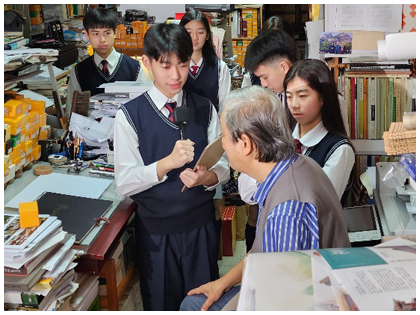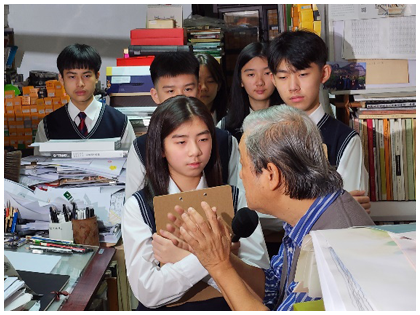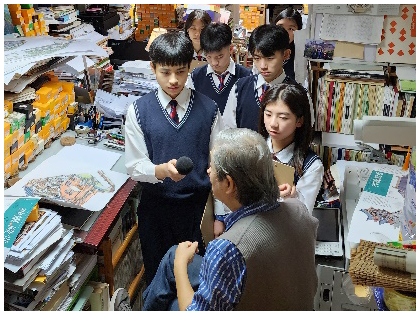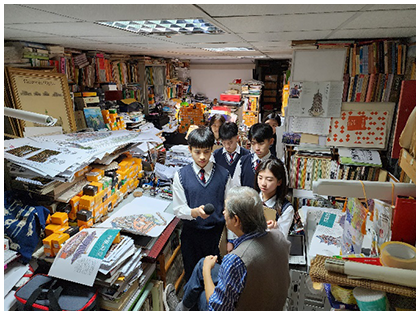Compiled by Edward Lu
Professor Interviews
|
Interviewing Professor Li Chien -Lang
| Q01. | Professor Li, what was the turning point for you to make up your mind to study ancient architecture? How did your first work, Residential Architecture of Kinmen, inspire your subsequent research on ancient architecture? (Maxine Huang)
|
Professor Li was mainly inspired by his father and two other professors. Later, after visiting many ancient buildings in Kinmen, Taiwan, and other regions, he became determined to study ancient architecture. The book, Residential Architecture of Kinmen, is a record of what the professor saw and heard when he served his military service in Kinmen, which started the path of writing books to record ancient buildings for him.


| Q02. | Professor Li, since 2005, you have been using hand-drawn drawings to see through ancient buildings, and hand-drawn traditional Chinese ancient buildings in an anatomical way. How can the bird's-eye view or deconstructed section perspective view in your hand-drawn drawings penetrate the walls so effortlessly? (Edward Lu) |
Professor Li said that the layman's view of the building is one-sided. The exterior is one side, and when they walk to the back of the building, they see another side. The interior is yet another angle, so the layman view is fragmented. However, in fact, there are a front, back, left and right side in a building, and we can even “open it up” to see the architecture’s inside. Generally, people see all the sides separately, but Professor Li has a way to conceive the architecture as a whole, looking at the all sides of the building - front, back, and inside, so it can be combined as a three-dimensional image. This is because when the professor was studying in the department of architecture, he drew floor plans, elevations, back views, top views, and sections every day. The professional training gave him the capability of perspective view and making hand drawings.
| Q03. | Professor Li, as far as we know, your painting was inspired by your father, you studied with Mr. Chen Jing-Hui, you joined the sketching club in high school years, and later you also befriended the painter Shiy De-Jinn. May I ask how each of these different stages of painting learning process has benefited you? (Edward Lu) |
As the saying goes, "When three are walking together, I am sure to find teachers among them." When we learn anything, the knowledge and skills that each teacher can offer are different. Professor Li also has some friends who are both his teachers and friends. Friends learn from each other and complement each other. The professor's father is very good at drawing architectural drawings. Professor Li has been nurtured by his father since childhood. He even has some special insights on how to sharpen pencils and how to draw the straightest lines with a ruler.
In elementary school, Professor Li learned painting from Chen Jing-hui, an art teacher of Tamkang Middle School. Mr. Chen is specialized in fine-painted “Eastern Gouache”, which is a Japanese painting method that uses a brush. Professor Li learned from Mr. Chen that observation is very important and one has to look very carefully to complete a painting. He realized that this is a scientific way to observe things, and even the hair and eyebrows can be drawn in great detail.
Afterwards, he had the opportunity to meet other painters, including Shiy De-Jin and Ma Pai-Sui, both of whom are famous for their watercolor paintings. There are also many teachers who he did not directly learn from, but he would buy their painting albums to study. Prof. Li said: "Every teacher has his or her strengths. You may only learn a part of him or her from each teacher, and it is impossible to get all the teacher’s expertise. It doesn't matter. Since each teacher has their strengths and the part they can teach you, you must master this part for sure. Learn from a few more teachers and you will become more complete.”
Most of Professor Li's painting teachers do not paint architecture but draw human body, still life, fruit, and other themes. Only Professor Li and Shiy De-Jinn take a liking to drawing buildings. However, he has gained knowledge and skills in copying, coloring, and modeling from the teachers. After mastering such skills, he can learn by analogy and start integrating the skills in his own style.
| Q04. | Professor Li, among the books you have published, many of them have won high achievements and awards, but I wonder which one is your favorite? Why? Also, I wonder which one took you the longest to write? (Daniel Ho) |
Professor Li's favorite book is his first book in Kinmen, Residential Architecture of Kinmen, and the book he spends his most time on is Great Craftsmen and Amazing Technique: Aerial Perspective of Classical Ancient Architecture in China , for which he spent two decades collecting materials before completing the beautiful paintings.


| Q05. | Professor Li, the "Cultural Heritage Preservation Act" was promulgated and implemented in 1982. What do you think about the importance of these related laws and regulations for the protection of historic sites in Taiwan? What is the special significance to you? (Christina Lee) |
The “Cultural Heritage Preservation Act” sounds very profound and far away from our daily life, but Professor Li told us that it is closely related to our culture. Because of these relevant laws and regulations, private buildings can also be identified as cultural assets, receive government subsidies, and then have funds to be maintained. He was very happy that the "Cultural Heritage Preservation Act" was promulgated and implemented, as many opportunities to preserve historic sites were lost without this law before. It turns out that the maintenance of historic sites is not just a verbal appeal to persuade more people to care about these beautiful buildings, but also a practical approach to be achieved by the law, in order to be efficient and effective.
| Q06. | Most people in Taiwan feel that the preservation and maintenance of historic sites will hinder urban development, and conflicts between development and preservation often occur during the review process. Is there any better way to improve the conflict during the review process and make the process quick and easy? (Sunny Yu) |
According to Professor Li, human knowledge and culture accumulate with time, and the area of land on the earth suitable for human habitation is fixed. If the old buildings are demolished for urban development and new buildings are continuously built, human beings will forget our ancestors. Government intervention can effectively help the preservation of historic sites. It seems everyone wants a new building, but if the government is willing to give the same benefits as building a new building to the owner of the historic site, I believe that the owner of the historic site must be willing to restore and maintain the traditional buildings of their ancestors and preserve them for generations to pass on.


| Q07. | Professor Li, you have been to many historic buildings and used architectural hand drawings with an aerial perspective to deconstruct them. Which building impressed you the most? (Aaron Chen) |
(quoting Prof. Li) “I am most impressed by the architecture in Taiwan and China. In Taiwan, I think the most impressive architecture is the North Gate, which has red walls, several holes, and semi-circular holes below. Inside the building on the second floor, it has two layers of walls, four wooden pillars, and carvings on the top. Surprisingly, the exterior of the North Gate is a fortress, a highly guarded citadel. However, its interior has carvings just like temples, displaying distinct styles. Therefore, I used architectural hand-drawing with an aerial perspective to demonstrate the internal and external differences. It is also worth mentioning that the architectural hand-drawing of the Lung-Shan Temple was the most challenging. Lung-Shan Temple has Buddha statues and a caisson ceiling. I visited the Temple ten times and spent about ten days accomplishing the drawing. I think architecture is a combination of stone and wood for sure, but it also has spirituality and life. After long-term contact, Lung-Shan Temple and I became good friends.”
“I visited a pagoda in the Shanxi Province of China. It is twenty stories high and constructed with wood. To my great surprise, each floor of the pagoda has different Buddha statues. After inquiring with a mage from Hong Kong, I realized that its construction was based on the concept of Buddhism. There is only one Buddha statue on the first floor, representing Exoteric Buddhism, and there are five Buddha statues on the fifth floor, representing Esoteric Buddhism. Firstly, the Exoteric, then Esoteric. Different state of mind corresponds to different Buddha statues. During the climbing of the pagoda, the architecture and space emphasize that body and mind are one. Although feeling tired, you will have different feelings. If a historic building is interesting or shows a sharp contrast, which makes me feel surprised, I would like to use architectural hand drawing to demonstrate it.”
| Q08. | Professor Li, since it is difficult to gather historic buildings to establish a museum, if the modern technology VR (virtual reality) is used to present the historic site structure, I believe it will be of great help to the inheritance and maintenance of historic sites. What do you think of the idea of establishing a VR historic site museum? We would like to ask for your opinion. (Daniel Ho) |
Professor Li feels that architecture is not only wood, cement, and bricks. When we walk into the historic sites, what we feel is not only the building itself, but also the flow of wind, smell, and location so that there are different feelings at each site. VR technology can help people who cannot go to the site in person, but to truly appreciate the beauty of monuments, you need to go to the site to feel the invisible atmosphere.
| Q09. | Professor Li, you once used the fire of thatched cottages as a metaphor for the restoration of historic sites, which conveys the sense of crisis in facing the preservation of historic sites. How should the government and related agencies arouse the public's awareness of the preservation of historic site? (Christina Lee) |
Professor Li made us realize that restoring a historic site to its original condition is basically an impossible task, but we still have to try our best. In addition, the lower the replacement ratio of historic site renovation, the more successful it is. In other words, the percentage of original objects must be high in order to restore the former appearance of a historic site as much as possible.
| Q10. | The preservation of historic sites and urban renewal are opposite events. Preservation of historic sites is very important, but urban renewal is an inevitable policy of the government, so the combination of historic sites and new buildings has emerged. In terms of aesthetics, what are your thoughts about this kind of architectural combination? (Sunny Yu) |
According to Professor Li, in an advanced metropolis, due to its long history, there must be buildings of different generations, which may be 100 years old, 50 years old, 30 years old, or new buildings about to be constructed. For example, the Louvre Museum in Paris has a history of more than 300 years. It has a century-old history with the Eiffel Tower in Paris. It is not against harmony for these traditional buildings to coexist with other high-rise buildings on the street. It still has the reputation of being the most beautiful street in the romantic city Paris. The combination of renovated historic sites and new buildings has become an architectural masterpiece of this generation.
| Q11. | Professor Li, what measures need to be taken to enhance the aesthetic experience of ancient architecture of the young generation and to expand their knowledge about historic buildings? (Aaron Chen) |
We can regard ancient buildings as old friends and visit them often. Or, we can think of a historic building as an old book; by reviewing it we can gain new insights. Historic architecture is similar to a treasure. Every time you visit it, you will get new findings. Also, we can view historic architecture as a tourist site. Before visiting it, do some research and use your eyes to observe it. The feeling is hardly understood by others. I have been to Hsinchu City God Temple. The couplet in the Temple is simple, connecting the imagery of rain and flower, but deeply impressed me. Therefore, every time you visit a historic site, you can observe different points. This will make you obtain different knowledge and understanding.
| Q12. | Professor Li, the maintenance of historic sites is inextricably linked to the craftsmen. What do you think is the best way to improve the skills of traditional artisans and cultivate the talents needed for the industry? (Maxine Huang) |
The Ministry of Culture in Taiwan has set up a course on the restoration of ancient buildings and invited various experienced craftsmen and professors to teach the course in order to cultivate "new blood" who are enthusiastic about the skills of traditional craftsmen. This is similar to the concept of a student going to a "tutorial" class, and after a period of study, he or she will receive a certificate in the craft. Although there are still some differences from the traditional "master-apprentice" system, and the content and proficiency of learning may be limited, the intensive training can still prevent the loss of traditional skills as much as possible.
Conclusion
This time we had the honor to visit the professor's studio, and it was an eye-opening experience to see the professor's precious original paintings and rich collection of books.
During the interview, Professor Li expressed his interest in ancient architecture after being inspired by the two professors when he was young. When he was in the military, he was able to take advantage of his leisure time to visit the local architecture of Kinmen, and to record and study it carefully. At the age of 29, he used what he had seen and heard during his military service to publish his first book on the Residential Architecture of Kinmen. This started the way for Professor Li to document his research on ancient architecture through hand drawings and publications. We highly admire his persistence and the spirit of research.
In the process of learning to paint, Professor Li continuously absorbed the characteristics and fortes of each teacher to enrich his own vision, and after constantly enriching and integrating the learned skills, he then gathers the great achievements of each school to refine his own painting skills. Therefore, in his architectural paintings, he can show rich colors and layers with ease. We were also greatly inspired by the learning methods and wisdom of Professor Li.
In addition, when Professor Li creates each architectural hand drawing, he would visit each building in person. In his paintings, he uses the technique of "deconstructive sectional drawing" to show the structure of each building from the front to the back, from the left to the right, from the top to the inside, and from every side in a single painting with great detail, fully showing the structure of the building. Professor Li even spent twenty years collecting data before he could complete the exquisite paintings in the book Great Craftsmen and Amazing Technique: Aerial Perspective of Classical Ancient Architecture in China. Whether it is the spirit of research and the amazing perseverance of his personal visits during the pre-creation period, as well as the patience and superb techniques in creation, they are all the best examples for us on the way of learning.
In this interview, we also realized that the "Cultural Heritage Preservation Act" makes the maintenance of historic sites more efficient and effective; on limited land, government subsidies and the attention of the general public have increased the willingness of historic site owners to restore and maintain their ancestral heritage buildings. Planned restoration and maintenance allow old and new buildings to coexist and prosper in our beautiful city. What is more, the Ministry of Culture has set up a course on restoration of ancient buildings, inviting professional craftsmen and professors to cultivate the skills of traditional artisans through intensive training. We believe that through the joint efforts of the government and the people, the precious ancient buildings will have a better chance of being preserved in the most beautiful manner.
Finally, Professor Li also encourages us to visit ancient buildings in person frequently, so that every time we visit, we will have new discoveries and different experiences, and learn new things by reviewing the past. He also emphasized the benefits of doing your homework beforehand and collecting information afterwards. To date, Professor Li has completed more than 70 research projects on historic sites and published more than 100 related books. This is all the results of his hands-on, studious spirit of inquiry, and the patience and perseverance to record at any time and carefully organize and describe what he sees and hears. Professor Li's academic spirit has set a model for us to engage in various research in the future. As the saying goes: "Listening to a master's talk is more inspiring than studying for a whole decade." The "Master Talk" with Professor Li was indeed beneficial and all of us returned home with a rewarding experience.



